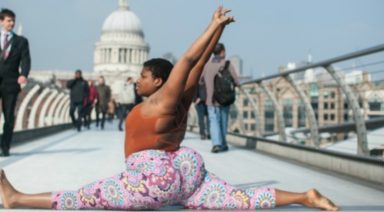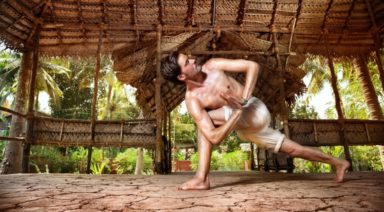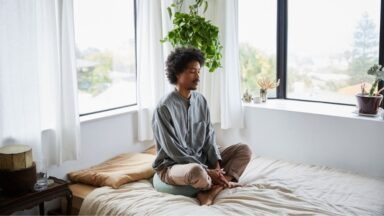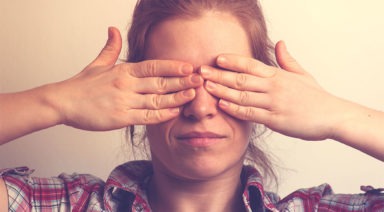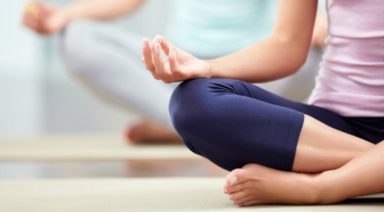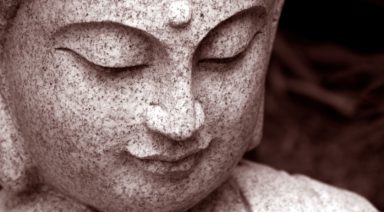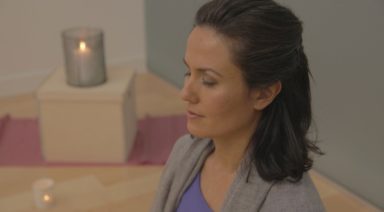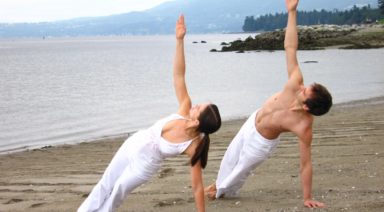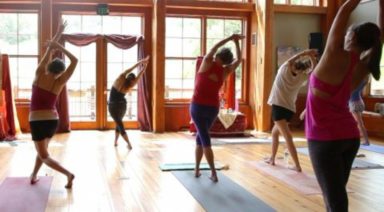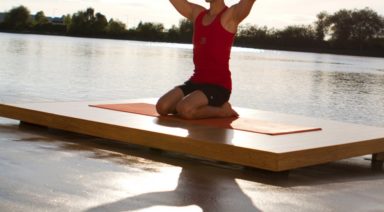Vernal Equinox: Ritual Through Yoga

Over the course of each year, our playful planet performs an elliptic dance around the sun while simultaneously spinning about its own imperfect axis, which tilts roughly 23 degrees from vertical. Born of the primordial fire, the terms of this intricate cosmic relationship are responsible for all of the natural rhythms that inform our daily lives — from changing weather patterns to reliable zeitgebers that regulate our internal clocks.
When one tugs at a single thing in nature, he finds it attached to the rest of the world.
::John Muir
The Story of a Blue Sphere and a Fiery Mass
As Earth diligently revolves around the sun each year, there are four distinct sandhis, or junctures, where a clear seasonal shift occurs from our terrestrial perspective. The vernal equinox is one such juncture, marking the transition from winter to spring.
As we welcome the appearance of new life in nature, many of us remain blissfully unaware. We may neglect or even override the innate curiosity that seeks to understand how our cozy blue sphere and its fiery solar star orchestrate this magnificent show year after year. The truth is, when it comes to their relationship status, “it’s complicated.”
A Practical Approach to Visualization
Imagine yourself sitting in a camping chair with your feet warmed by the heat of a well-burning fire. Fortunately, you’re equipped with a warm scarf and hat to dull the chill you might otherwise experience as you recline back (at exactly 23.4°) to enjoy the stars. Now, without adjusting the direction your chair is facing, imagine yourself orbiting around the focal fire to the opposite side, giving the back of your head a chance to enjoy the warmth of the flame.
If your feet were the southern hemisphere and your head where the northern hemisphere, these two positions would represent the winter solstice (with more heat reaching the bottom half of your body) and the summer solstice (with more heat reaching the top half of your body) respectively.
To visualize the vernal equinox, imagine your chair was to revolve just a quarter of the way around this campfire circle. In this position, your body would be leaning neither toward nor away from the fire and the projected plane of your navel (the equator of your body) might pass directly through the center of the glow. Also, the light reaching one side of your body would match the darkness on the opposite side, much like the day and night which are of approximately equal length on the equinox.
Still confused? Don’t sweat it, simply allow yourself to enjoy the fruits of spring with a deep knowing that there are some wildly wonderful forces at play.
Emergence of the Exhale
Played out on a living, organic sphere, the seasons are guided by a unique planetary breath rhythm. The annual breath of the Earth, much like our own cyclical respiration, serves the purpose of bringing nutrients into the system in exchange for that which cannot be utilized. During the Vernal Equinox, our sleepy planet awakens from the depth of its winter inhalation and begins a 6-month out-breath.
Lean into the Light
Illustrated in the table above, the vernal equinox is a point of orbital balance marking the emergence of days that outlive nights as the axis of the planet bows once again, toward the sun. In direct response to increasingly available sunlight, a life that remained dormant in the barren winter months begins to awaken in receipt of new light. All of nature comes to life — hibernating creatures wake up with healthy appetites and germinating plants shed the shackles of their seeds.
“For a seed to achieve its greatest expression, it must come completely undone. The shell cracks, its insides come out and everything changes. To someone who doesn’t understand growth, it would look like complete destruction.” ::Cynthia Occelli
Subtle Body Spring: Melting the Inner Snow
As nature begins to melt the winter snow in spring, rivers and far-reaching tributaries swell with freshwater that sustains the natural environment as well as human communities. Mirroring the wisdom of the planet, now is the time to water any seeds of intention we may have planted at the beginning of the year and evaluate which future crops and creative projects we will irrigate with the melt of our inner snow.
Just as mountain rivers are swelling their waters, our bodies respond in much the same way at this time of year. This is nature’s way of melting the inner “snow” of the body.
::Shiva Rea, Tending the Heart Fire
Recalibrating Rhythm
Like a bear emerging from the deep sleep of hibernation, sometimes it can be difficult to recalibrate the body and mind for the vibrant spring rhythm. During the long period of seasonal darkness that precedes the vernal equinox, the body naturally increases melatonin production, a hormone that promotes the desire for sleep. This is the planet’s way of encouraging us to slow down and regenerate during fall and winter.
However, with the advent of smartphones and 24/7 connectivity, we override many of these environmental signals which can disrupt our natural circadian rhythms. This dissonance may leave energy levels, which were supposed to have been replenished during the winter, somewhat depleted when springtime arrives.
Fortunately, the daily increase in sunlight that occurs during this half of the year, has its own subtle body effects which include an increase in the mood-elevating hormone, serotonin as well as testosterone and estrogen.
While the shift in our internal chemistry generally increases energy and vitality, this period of hormonal recalibration puts a strain on the endocrine system which can leave us feeling a little tired as we meet the seasonal transition. To navigate the changing internal landscape, any effort to cleanse and detoxify the body can help alleviate energetic stagnation in preparation for the luminous spring ahead.
The Kappa Season
The predominant dosha during springtime is kappa, comprising earth and water. With heavy rains and warming temperatures, the elemental density and heaviness of kappa in late winter continues into spring. As we approach the equinox, it becomes necessary to balance these kappa qualities in order to alleviate winter-induced inertia and energetic malaise. The ideal rhythm for springtime is kappa-pacifying: meet the cool, oily, and heavy qualities of earth and water with the arid warmth and lightness of air and fire.
- Lighten Up. The vernal equinox welcomes a thorough spring cleaning, in our homes and in our hearts. Start by addressing any clutter that has accumulated during the winter and dispose of it in a meaningful way. In your home, this might be as simple as donating articles of clothing or re-purposing a piece of furniture. In your heart, you might tune into the presence of any heavy emotions, assimilate what you can learn from, and let the rest dissolve. Write in a journal to rid your subtle body of excess energetic weight and to create space for what is to come. Only once you have cleared any obstructions, can you begin a deep clean.
- Cleanse. Since kappa is able to sustain with or without food, enjoy a short fast or cleanse during the spring season using astringent fruit juices or warming, spiced kitchari. To stimulate the digestive fire before meals, try chewing on a small slice of fresh ginger. Shed layers of winter skin by dry-brushing before bathing and minimize the use of body oils. If you find yourself battling allergies with spring fever, consider cleansing the nasal passages with nasya, herb-infused oil, to facilitate the clear exchange of Prana. Alternatively, this can be done with warm salt water using a neti pot.
- Nourish. Concentrate on slow, mindful meal times so that your body experiences maximum satiety to avoid overeating or emotionally driven consumption which are symptoms of excess kappa. Favor light foods that are easy to digest with pungent, bitter, and astringent tastes. Foods like apples, pears, brussels sprouts, cabbage, and carrots for instance. Avoid heavy, oily foods with sweet, salty and sour tastes which increase kappa.
Invigorating Yoga Practices for the Spring Equinox
To bring balance to the gunas (attributes) of the kappa season, we emerge from the regenerative practice of the cold winter months and transition into the increased energy and mobility of spring. As we adapt to the seasonal rhythm, the most beneficial physical practices are those that enliven vira rasa. The term rasa can be used to define the intrinsic energetic quality or essence of being and vira is a word for hero. Vira rasa is the embodiment of potency and courage which are reinforced by an active, solar practice. This particular movement alchemy is appropriate for any time when we are experiencing a cycle of growth and renewal.
- Summon Your Strength — Enjoy arm balances and core cultivation as well as heating inversions to experiment with a new strength that has developed from the fortifying rest of winter.
- Clear Congestion — Relieve physical and emotional congestion by practicing dynamic postures with a vigorous pace before exploring strong, standing hip-openers, and activation. This can mobilize stagnant earth and water elements that may have accumulated here through winter.
- Burn Bright — Experience the ardent internal cleansing of heat-inducing pranayama such as kapalabhati, bhastrika and surya bhedana.
- Detoxify — Any process of purification requires a great heat. In the same way that steam can disinfect the surfaces in your home, internal heat and massage can assist the body’s natural metabolic processes which rid the system of toxins and purify the cells while reducing inflammation. Focus on postures that stimulate the circulatory, digestive and lymphatic systems like bound twists and activating backbends.
Spring Equinox Sequence: Moving Meditation for the Whole Body
Heart
Tap into your innermost virya, meaning vitality, enthusiasm, and effort, with focus and attention. Maintain an affirmative inner dialogue and embody the heart of a warrior. Either internally or aloud, invoke the mantra of supreme light with reverence to the sun, our absolute source of sustenance. Allow this to be a mantra of purification and release as you move toward internal balance.
OM HRIM HAMSA SO’HAM SWAHA
om: the primordial sound of the universe, the vibration of all creation, the guru
hrim: bija, seed sound for clarity and dispelling illusion, mantra for the cosmic light, the sun
hamsa so’ham: the balance of light and dark, sun and moon, Shiva and Shakti, the power of the breath for bringing vitality
swaha: let it be so, dedication to the light
*translations by David Frawley
Breath
During this stimulating practice, focus on powerful ujjayi breathing to circulate a steady supply of oxygen through the blood. Maintain a strong, audible breathing rhythm through the nostrils, releasing heat through the mouth on the exhale as needed. With this victorious yogic breath, internal body heat increases as does the circulation of Prana.
Body
This practice is a pilgrimage to Natarajasana that alchemizes twisting and backbends to open the channels of the spine and create space in the body. Beginning with an energizing kriya, we employ the breath to heat and polish the body from the inside out. What follows is a series of progressive twisting namaskars to energize and open before diving into standing backbends. The practice will close with deep-seated hip openers to alleviate emotional congestion before releasing into final relaxation.
To support your self-practice, please refer to the pose breakdown below with links to photos and alignment for each posture or enjoy the complete guided sequence video.
The Glass Ceiling of Yoga: Body Positivity
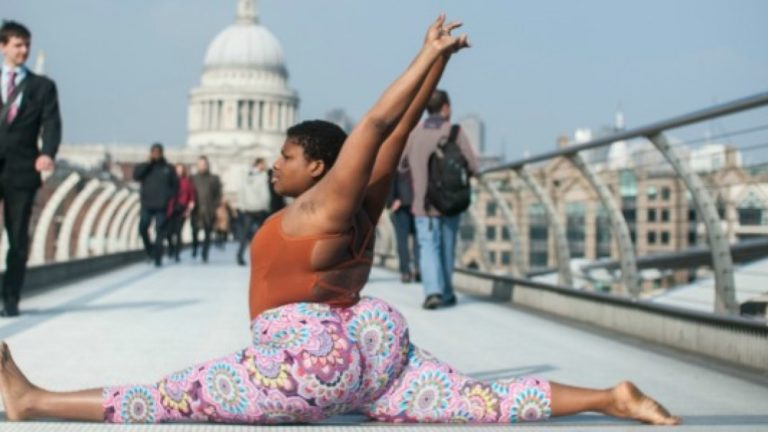
The picture of a serene and beautiful yoga community that is celebrated by the media actually disguises a disturbing layer of normalized and ubiquitous body type discrimination. However, by unveiling a previously “invisible” glass ceiling over the Western yoga community, students, teachers, and administrators can find ways to effortlessly mold body-positive practice spaces for current, new, and future yoga practitioners.
Gender vs Body Type
I’ve encountered a lot of glass ceilings in my life. Honestly, when you’re black, queer, and born with female genitalia, you encounter them constantly and I’ve grown to expect situations wherein boundaries and limitations are the norm. However, there’s a glass ceiling that limits our Western yoga community to a troubling degree and it’s something I never expected to encounter. I mean, when “glass ceilings” are typically identified in Western society, they are almost invariably related to gender.
Ironically, the yoga community doesn’t really suffer from a gender glass ceiling, at least not one that negatively effects women.
Even though women weren’t taught asana until the 20th century, the vast majority of Western yoga teachers and students are female. And while discrimination against male yoga students and teachers is probably more common than any of us could imagine, it’s still not the most expansive and divisive glass ceiling in the yoga community.
No, the real ceiling within our community is based entirely upon physical presentation and, specifically, body type.
This ceiling is clear as day to those of us who have atypical yoga practitioner bodies. Instead of being slender, white and heaped with physical ability, there’s a growing wave of yoga teachers and students who are plump, multiethnic and powering through life with a wide range of disabilities. However, those of us who challenge the white washed yoga teacher stereotype face a very different practice landscape than our colleagues. For example, it’s inappropriately common to hear a story about a yoga student being shamed out of a yoga studio, based upon comments made by discriminatory yoga teachers and students.
In some communities, it’s nearly impossible for atypical yoga teachers to find teaching opportunities. And even when teaching opportunities are available, they are not on par with options for more traditionally bodied teachers. This problem is well documented within small communities of “different” yoga teachers, but it’s essentially invisible to those who don’t see themselves as “different”. And, what’s worse, there are way too many practitioners and teachers who don’t see this kind of discrimination as a problem. Thus, an “invisible” glass ceiling has domed over our community, and only those who have been discriminated and oppressed are fully aware of its existence.
What Does This “Glass Ceiling” Actually Look Like?
Here’s the thing, no one in the yoga community is ever going to openly bad mouth someone who looks different from the traditional idea of a practitioner. Ok, let me back up. I’m sure it happens. But being openly mean to people is not condoned in our yoga community. It’s a pretty big no-no, actually. Therefore, I wouldn’t be surprised if someone reading this article right now is truly shocked by the idea that discrimination exists in a community which oozes the kind of saccharine sweetness that can only be honed by decades of marketing and product advertising. Unfortunately, the prettiest bandages can hide the ugliest wounds.
And beneath the surface of our saccharine sweet, mass media approved industry is a festering wound characterized by offensive language, discriminatory hiring practices and a bunch of other negativity that gets swept under the rug.
Admittedly, it’s not fun to acknowledge discrimination. In most cases, it feels very embarrassing, and many people would prefer to pretend as though they are not part of the problem. But anyone who turns a blind eye to this problem is also a key contributor to its existence. But how does this problem actually manifest and what does it look like? Let me paint a clearer picture for you.
Imagine you’re a curvy person who has finally decided to face your fear of practicing yoga in a group setting. Perhaps you’ve practiced yoga online with free videos, and you’re finally feeling confident enough in your understanding of asana to venture out of your living room and into a communally supportive environment under the watchful gaze of a knowledgeable instructor.
With a yoga mat under your arm and an emotionally swollen heart on your sleeve, you proudly stride into your local yoga studio.
When you approach the reception desk to check-in for class, the teacher (who looks, as expected, like a human Barbie doll) gives you a curt visual once-over. “Is this your first class?” Yoga Teacher Barbie chirps nonchalantly. While your knee jerk reaction may be defensive, you calm yourself down mentally. You remind yourself that she’s not trying to be offensive, and that she’s merely trying to take the proverbial temperature of a student she’s never met before. You smile and shake your head. “Nope, but I’m excited to take your class!” you say. Barbie smirks. “Well, this class is pretty intense,” she says.
You stare at her blankly. You’re wondering why she’s decided to tell you that the class is intense. Is it because she thinks you can’t handle the class? All of a sudden, you’re second guessing yourself and hiding sweaty palms. Why did you think you were strong enough to attend live classes? By the time you’ve rolled out your mat and gotten settled with props, the tissue thin confidence you brought into the studio has been shredded beyond repair by the self-doubt you’d managed to keep at bay prior to arrival.
During the class, you notice for the first time that your expressions of various yoga poses look a little different than other people in the class. Maybe your balance is a little less sharp, or you use props and modifications at times when other students seem to be able to go without. While that acknowledgement makes you a little self-conscious, it pales in comparison to the shame you feel at having your movements constantly corrected by Yoga Teacher Barbie.
Because, yes – Barbie has also noticed that your movements look a little different. And she’s decided to make your differences an opportunity for a teaching exercise by constantly correcting your alignment and offering more physical adjustments than you could have ever wanted. Ultimately, it doesn’t matter if she’s offering more or less advice to anyone else in the room – in fact, it’s entirely possible that she offers this level of adjustment to every student. But your confidence has been shattered.
The emotionally swollen heart you proudly wore on your sleeve is now openly bleeding.
In the best case scenario, you somehow find the strength to believe in yourself again. In the worst case, you vow to never darken the doorstep of another yoga class for fear of ever feeling this way again.
The thing is, if you’re reading this right now, you’ve probably worn the moccasins of either Yoga Teacher Barbie or our Curvy Protagonist. Maybe both. And the weird thing is, I’ve heard this exact same story told by people who are not necessarily “curvy” or “different” in some other way.
In fact, it’s startlingly common for people who look just like Yoga Teacher Barbie to still feel discrimination at the hands of their instructors.
I could be wrong, but I think this is all the result of the fact that we live in a staunchly body negative society.
Body negativity is endorsed by the mass media – let’s face it, that’s how they get us to buy things. We make purchases because we find ourselves wanting or lacking in one way or another. Unfortunately, in addition to the mass media, body negativity has also fully permeated the yoga community. In fact, many teachers believe their discrimination isn’t discrimination at all – they see it as a kind dose of realism to students who don’t meet their personal standards of yoga perfection. Because that’s really all discrimination is – it’s the state of our judgment when we encounter people, places, and things which jibe with our personal definitions of perfection.
It’s sad to see this happen in a community which has the potential to include every single human being on the planet. Frankly, it’s not absurd to imagine a world where everyone practices a style or hybrid blend of yoga. However, that reality will never come to fruition if we don’t resolve the body negativity and discrimination problem. How do we do that? Well, fight fire with fire.
If body negativity is the disease, then body positivity must be the antidote.
The Antidote: Body Positivity
Body positivity is frequently confused concept. It’s pretty confused even within the body positivity community. You could get a different definition depending on the person you ask, the day of the week, etc. Some people think body positivity is solely tied up in body size acceptance, and others might even go so far as to equate it with fat acceptance and fat positivity. While fat positive movements have their rightful place of importance in the evolution of our society, I don’t believe they are synonymous with body positivity. Another popular way of describing body positivity is by equating it with constant self-pep talks. You know, a pattern of methods to remind yourself that “I’m Great! I’m Beautiful! I’m worthy of breathing oxygen in front of other humans without feeling suicidal!” While pep talks are rad and I fully endorse them, I don’t think they speak to the core of body positivity.
You see, body positivity assumes your constant perfection. It assumes that you’re always beautiful. That you’re always worthwhile. That you’re always capable. That you’re always strong.
In a truly body positive world, these statements are not up for debate – instead, they are seen as impenetrable fact. The only perspective up for debate is that of each individual – are you willing to accept your own perfection? Especially when the mass media tells you that those statements are definitely not true. Body positivity is the confidence to accept your constant perfection and beauty, no matter the proverbial weather. And, most importantly, to accept the constant perfection and beauty of those around you, even if they look and act different from yourself.
When we implement body positivity in our yoga studios and spaces, we create environments where students across an infinite spectrum of differences all feel as though they are equal to one another. This type of attitude is absolutely critical in order to see the yoga community grow beyond the one dimensional image offered by the media. Body positivity doesn’t mean teachers aren’t free to offer alignment tips and adjustments to their students without fear of offending someone. But it does mean that every word, every gesture, and every moment is an opportunity to be encouraging. To make someone feel welcome. To actively avoid discouragement.
Eventually, this kind of environment will lead to the end of classes where certain students are viewed as superior to their fellow students. Good riddance, as far as I’m concerned. This is a glass ceiling that desperately needs to be shattered.
We must all take responsibility for the role we play in a yoga culture which is thoroughly embedded in discrimination and negativity.
We need more than a few people who are proud of their bodies. We need a legion of yoga teachers, administrators and advanced practitioners who truly walk the walk of the eight-limbed path, and who will stop at nothing to spread the practice to every soul across the planet.



